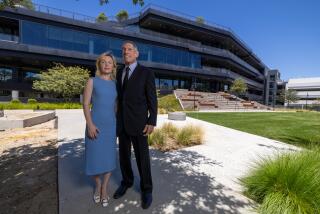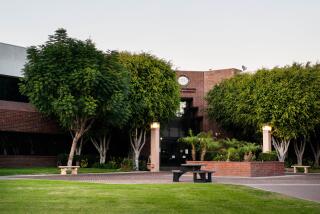Mattel to Give $25 Million to UCLA Hospital
In what is being described as one of the largest-ever corporate cash gifts, Mattel Inc. today will sign over $25 million to UCLA to rebuild its Children’s Hospital.
The new 102-bed facility will be renamed Mattel Children’s Hospital at UCLA. It will feature a 5,000-square-foot lobby with larger-than-life replicas of Mattel’s Hot Wheel’s vehicles, Fisher-Price’s Little People and, of course, Ken and Barbie.
Modernist architect I.M. Pei will draw up plans for the lobby as part of his overall design of UCLA’s new $1.1-billion medical center. The university is building a state-of-the-art medical center to replace its 1940s-era facility, which was damaged during the 1994 Northridge earthquake.
Pei’s architectural designs for the center will be unveiled Jan. 17, the fifth anniversary of the quake. The pediatric hospital is scheduled to open in 2004.
Jill E. Barad, chairwoman and chief executive of the El Segundo-based toy giant, will present the $25-million check to the dean of the UCLA School of Medicine, Gerald S. Levey, during a ceremony outside the current Westwood facility.
The money will cover 75% of the costs for the new building, Levey said.
“Mattel toys have made children happy for years,” Levey said Wednesday. “Now Mattel also will help make children well.”
Experts said the gift, which is tax-deductible, is a can’t-lose deal for the world’s largest toy maker.
By cementing its name on the UCLA building, Mattel will be linked with one of the nation’s leading children’s transplant and research facilities.
“It’s a lasting kind of advertising, and money well spent over a period of time,” said James Bell, a partner with Lippincott & Margulies, a New York corporate identity consultant.
Barad said Mattel is not making the gift to promote its products, although the firm has agreed to furnish all the children’s rooms with Mattel toys. And Mattel officials already are talking with Pei’s team of architects about making the lobby--where sick children and their parents will enter--the centerpiece of the hospital, with Mattel toys and interactive games filling the room.
“We want this room to demystify a hospital,” Barad said. “It should be a place where kids would say that if I have to go to a hospital, let it be there.”
Mattel and university officials began talking about a possible gift from the company a year ago, after Hollywood’s onetime super-agent, Michael Ovitz, introduced Barad to Levey, officials said.
Ovitz, a UCLA alumnus and chairman of the UCLA Medical Sciences executive board, has donated $25 million of his own money for the rebuilding project.
Mattel had initially wanted to give up to $5 million for the project, but Levey and other university officials prodded the firm’s board to give more to secure Mattel’s name on the building. The $25 million will be given over seven years through the firm’s Mattel Foundation.
The gift represents a small portion of Mattel’s $272 million in net income so far this year. Last year, the company netted $285.18 million.
Barad described the gift as “a marriage meant to be. We were looking for a hospital that helps children, who’ve helped to make our firm so successful.”
“I don’t think we’ve ever felt better about doing anything with our money,” she said.
Laurie Fundukian, an editor with Corporate Giving Watch, a Farmington Hills, Mich., newsletter that tracks corporate gifts, said she knew of no larger corporate cash gift to a single institution.
Corporations “underwrite, they sponsor and make non-monetary donations, but rarely do they make such large splash cash grants,” she said.
For example, Microsoft Corp. donated $90 million to various universities and charities this year, but only $17 million was in cash, with the remainder mainly free software, Fundukian said.
Some corporations have been criticized by shareholders for arbitrarily donating money that could have been used to pay extra dividends.
But Faith Kahn, a New York Law School professor who has studied corporate giving, said such criticisms of Mattel are unlikely. Instead, she said, shareholders will probably benefit from the goodwill a gift of this kind evokes from employees and the local community.
“There is probably nobody that could find giving to a children’s hospital controversial,” Kahn said. “This is the safest kind of giving. It’s a tie-in with the product.”
More to Read
Inside the business of entertainment
The Wide Shot brings you news, analysis and insights on everything from streaming wars to production — and what it all means for the future.
You may occasionally receive promotional content from the Los Angeles Times.









